Since I moved to the U.S. in 2001, I have been mystified about this strange, nearly ubiquitous phenomenon known as the Alfredo sauce.
I mean: how could I, a food journalist and recent transplant from Italy, not know about it? Yet it was everywhere I turned in the U.S. — on Italian menus, on supermarket shelves, even in commercials. Friends would ask for my recipe.
Well, quite frankly, I had no idea who this Alfredo was or why his sauce was everywhere!
My Italian-Italian friends (who had, like me, moved in recent years) shared this same experience. Maybe some of you, too, have glimpsed a perplexed expression on your waiter’s face after you tried to order the dish in a restaurant in Italy.
Was the sauce an Italian-American recipe, created by Italians after they had moved to the States? Or was Alfredo a chef, carrying an Italian name, so that everyone believed that the recipe was Italian?
My quest for an answer to all these doubts coincidentally came to a close during a Christmas holiday in Rome two years ago.
Enzo, one of my aunt’s best friends, was giving me suggestions for restaurants close to our hotel when he casually dropped the name Alfredo, in via della Scrofa, “a classic, a very famous venue especially in the Forties and Fifties, among American Hollywood stars and celebrities.” That rang a bell. Was Alfredo alla Scrofa serving a special dish that carried his name? Oh yes, my friend added, they have their fettuccine with Alfredo sauce…. Ah-ha!!!!
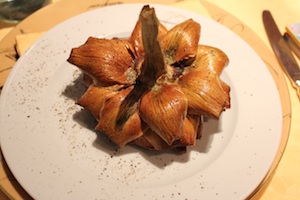 |
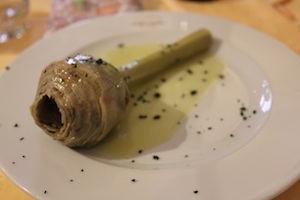 |
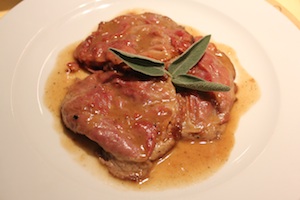 |
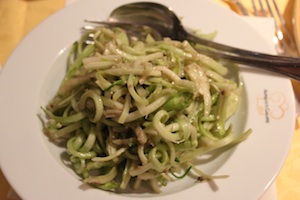 |
The ingredients, in the real Alfredo recipe, are very basic: butter and Parmigiano-Reggiano cheese. No cream, no other weird stuff. The pasta is a regular egg-and-flour tagliatelle. And no big preparation secrets either: they mixed the ingredients right in front of me…. Why then was the result is so creamy, so different than the ordinary butter-and-cheese pasta we all eat at home?
Back at home, I tried several times to recreate the dish, with just OK results. I figured the technique was more or less the same as another famous dish from central Italy: the pasta cacio e pepe, or pasta with cheese and freshly ground black peppercorns. I even bought and tried making the recipe with the restaurant’s own tagliatelle.
 |
 |
| I used the recipe on the back of their box, but the butter amount didn’t seem right to me. |  |
It took me several attempts to come up with what appeared to be the right balance of butter, cheese and water.
To make sure I was on the right path, I connected once again with the restaurant, trying to gather more clues.
Mario Mozzetti, co-owner of Alfredo la Scrofa, very kindly answered all my questions.
One of the secrets of the recipe resides in the tagliatelle (or fettuccine) itself.
The fresh ones, served at the restaurant, are made with North American or Canadian Triticum Aestivum (called farina di Manitoba in Italian), a high-protein wheat flour, and fresh eggs. They are then extruded through a very fine mold, making sure they are paper thin (5 millimeters). They cook in only 5-10 seconds! They are then drained and mixed in a previously warmed serving dish together with some softened butter, cooking water, and plenty of extra aged (preferably 36 months) Parmigiano-Reggiano cheese.
As I pursued the recipe, my investigations lead me to another mystery surrounding the famous dish and its provenance.
The restaurant Alfredo la Scrofa was sold during World War II, in 1943, “with all its belongings” by Alfredo to his two waiters, Giuseppe (grandfather of Mario Mozzetti) and Ubaldo (great-great grandfather of Veronica Salvatori, current co-owner with Mozzetti).
Seven years later, Alfredo di Lelio, perhaps regretting his decision, opened another restaurant a few yards from via della Scrofa, in Piazza Augusto Imperatore, naming it “the original,” “Il Vero Alfredo” (the true Alfredo). Nowadays that eatery is owned by Alfredo’s heirs’ family members, Ines Di Lelio and Alfredo III Di Lelio, grandsons of the recipe’s inventor. The decor of the restaurant, judging from the photos on their website, appears similar to the eatery in via della Scrofa, complete with signed portraits of celebrities adorning the walls.
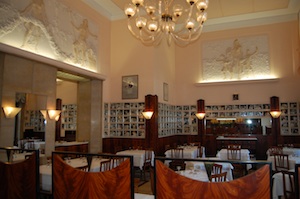 |
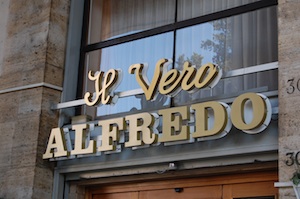 |
| From the pictures Alfredo’s inheritors collected since the Fifties, you can imagine Alfredo III probably carries the same outgoing personality traits (together with the moustaches) that enchanted the two Hollywood actors in the Twenties. | 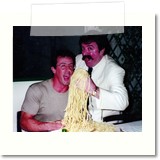 |
In their online gallery, just take a look at the entertaining pictures of James Stewart and Gina Lollobrigida, their faces a mixture of astonishment bordering on fear, as Alfredo leans close with a huge, almost threatening handful of uncooked fettuccine.
But the golden heirloom became the first dispute between the two restaurants.
The Di Lelios claim ownership of the golden fork and spoon, which was donated “to Alfredo” and not to the restaurant (and therefore was not part of the restaurant belongings), that – they say – they still own the famed utensils. And, according to their website, the fork and spoon have a different inscription: “to Alfredo, the king of the noodles” instead of just “to Alfredo.” Mario Mozzetti, owner of Alfredo la Scrofa, instead insists that the silverware was part of the restaurant belongings, and that the original fork and spoon were stolen in 1978 from his restaurant. So the ones I used were in fact a copy of the originals (well, still an amazing experience!).
Of course, the argument is also about another, maybe more important heirloom: “who is serving the authentic dish.”
The Di Lelios of course serve fettuccine Alfredo as well, but I haven’t tasted their dish… yet (I will make sure I will visit this restaurant as well on my next trip to Rome), so I felt I needed to ask more questions about their grandfather’s recipe.
Chiara Cuomo, daughter of Ines Di Lelio of “Il Vero Alfredo” restaurant, revealed to me some of the secrets of their fettuccine recipe, “my grand granddad’s original recipe,” which is a little bit different from the one served in via della Scrofa.
The Di Lelios prepare a very thin fettuccine using durum semolina and using butter with higher fat content than usual. They also prefer younger Parmigiano-Reggiano, instead of the older variety, and they mix in cooking water as well. The exact aging of the cheese and the precise kind of butter remain a secret, but she confirmed to me (as did Mario Mozzetti, from the other restaurant) that the proportions among ingredients that I came up with are about right.
Craving for the real recipe for Fettuccine with Alfredo sauce?
Links:

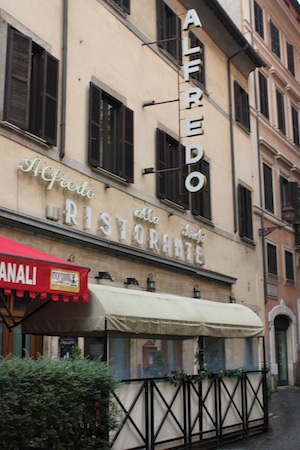
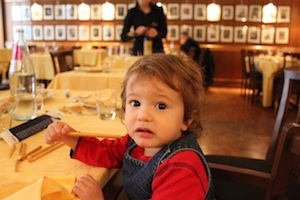
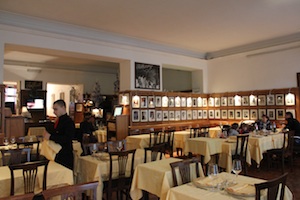
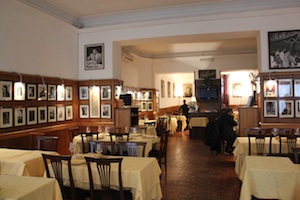
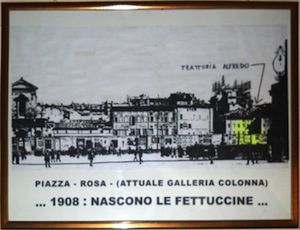 Alfredo wanted to feed her something simple, healthy, tasty and very nutritious at the same time. So he concocted a luscious but simple combination of pasta, cheese and butter. The dish quickly became a staple in his restaurant, which he had purchased the year before.In 1927, Mary Pickford and Douglas Fairbanks, stars of the silent movies, visited the eatery during their honeymoon in Rome. They absolutely loved the dish, to the point that, once back in the United States, they started a very fond PR campaign among their friends in Hollywood. More than that, they engraved a giant golden fork and spoon with their names, and gave them to Alfredo.
Alfredo wanted to feed her something simple, healthy, tasty and very nutritious at the same time. So he concocted a luscious but simple combination of pasta, cheese and butter. The dish quickly became a staple in his restaurant, which he had purchased the year before.In 1927, Mary Pickford and Douglas Fairbanks, stars of the silent movies, visited the eatery during their honeymoon in Rome. They absolutely loved the dish, to the point that, once back in the United States, they started a very fond PR campaign among their friends in Hollywood. More than that, they engraved a giant golden fork and spoon with their names, and gave them to Alfredo.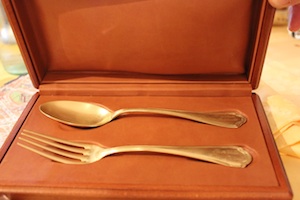
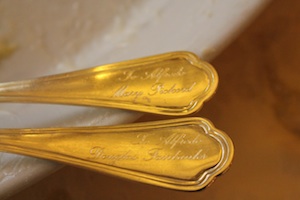
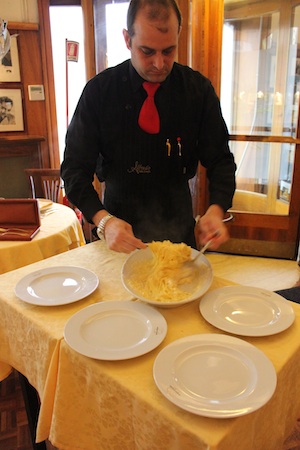
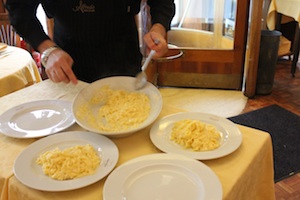
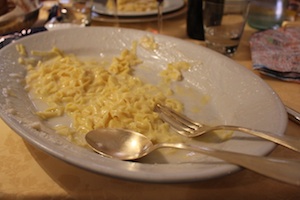
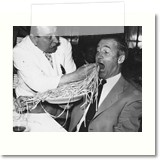
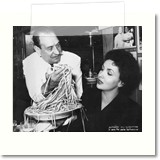
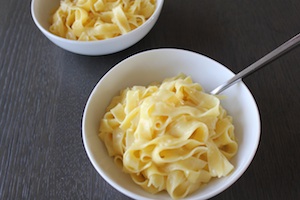
Bravo, Garzia for setting up the blog and for grabbing me with not only wonderful descriptions of food, but a fascinating story too. I look forward to seeing the recipe for Alfredo sauce when it is posted. Good luck with this endeavor. I am sure it will be a success.
[…] alfredo is mixed tableside, often with the Pickford and Fairbanks golden fork and spoon (each has a set they claim to be the original). Singers serenade tourists as they feast. Elsewhere, you’ll have to ask […]
Exactly! Although the pasta al burro you find in other restaurants is not as creamy as in the alfredo recipe…
HISTORY OF ALFREDO DI LELIO CREATOR IN 1908 OF “FETTUCCINE ALL’ALFREDO”, NOW SERVED BY HIS NEPHEW INES DI LELIO, AT THE RESTAURANT “IL VERO ALFREDO” IN ROME, PIAZZA AUGUSTO IMPERATORE 30
With reference of your article I have the pleasure to tell you the history of my grandfather Alfredo Di Lelio, who is the creator of “fettuccine all’Alfredo” in 1908 in restaurant run by his mother Angelina in Rome, Piazza Rosa (Piazza disappeared in 1910 following the construction of the Galleria Colonna / Sordi).
Alfredo di Lelio opened the restaurant “Alfredo” in 1914 in Rome (Via della scrofa), after leaving the restaurant of his mother Angelina.
In 1943, during the war, Di Lelio sold the restaurant to others outside his family.
In 1950 Alfredo Di Lelio decided to reopen with his son Armando his restaurant in Piazza Augusto Imperatore n.30 “Il Vero Alfredo” (“Alfredo di Roma”), whose fame in the world has been strengthened by his nephew Alfredo and that now managed by me, with the famous “gold cutlery” (fork and spoon gold) donated in 1927 by two well-known American actors Mary Pickford and Douglas Fairbanks (in gratitude for the hospitality).
See also the site of “Il Vero Alfredo” http://www.ilveroalfredo.it, which also contains information on franchising.
I must clarify that other restaurants “Alfredo” in Rome do not belong to the family tradition of “Il Vero Alfredo” in Rome.
I inform you that the restaurant “Il Vero Alfredo” is in the registry of “Historic Shops of Excellence” of the City of Rome Capitale.
Best regards Ines Di Lelio
Thank you Ines!!! Ciao da Portland!!!
How interesting! Thanks for sharing 🙂
Maybe you will explain the history of garlic bread next 😉
Maybe!
[…] my on-the-ground research – here it is for you – the real, authentic fettuccine with Alfredo sauce recipe! […]
[…] Curiously, the Fettuccine Alfredo also has a totally American story… […]
[…] Lelio was the owner of a famous restaurant in Rome in 1914 and his signature dish was a pasta that he named after himself. He opened a restaurant in New York as well, which lead to the misconception that Fettuccine Alfredo […]
Hi! Thank you for posting! Well, the restaurant in New York opened only in the Seventies, way after the recipe was already famous in the US. The restaurant opening was in fact the consequence of the the fact that the recipe was already famous, not the other way around. And, the fact that the recipe was famous only in the US (again, not because of the restaurant, but because of Mary Pickford and Douglas Fairbanks) made me (as well as many other Italians) think that the recipe was American. Ciao and buona appetito! Grazia
[…] Lelio was the owner of a famous restaurant in Rome in 1914 and his signature dish was a pasta that he named after himself. He opened a restaurant in New York as well, which lead to the misconception that Fettuccine Alfredo […]
[…] in American Italian restaurants. For the full story, see the Italian-American culinary website COOKWITHGRAZIA.COM or follow the link from The DIY Bistro Facebook […]
… [Trackback]
[…] There you will find 9238 more Infos: cookwithgrazia.com/food-tales/alfredo-sauce-mystery-solved/ […]
[…] name. Depending on the tale you’re reading, Alfredo di Lelio first made his version either in 1908 or 1914. The story goes he was looking to create a mild meal his pregnant wife could stomach and […]